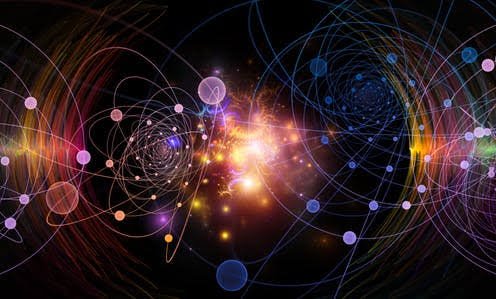
Quantum is the Latin word for amount and, in modern understanding, means the smallest possible discrete unit of any physical property, such as energy or matter. Quantum came into the latter usage in 1900, when the physicist Max Planck used it in a presentation to the German Physical Society.
What is Quantum Physics? Put simply, it’s the physics that explains how everything works: the best description we have of the nature of the particles that make up matter and the forces with which they interact. Quantum Physics underlies how atoms work, and so why chemistry and biology work as they do.
Niels Bohr and Max Planck, two of the founding fathers of Quantum Theory, each received a Nobel Prize in Physics for their work on quanta. Einstein is considered the third founder of Quantum Theory because he described light as quanta in his theory of the Photoelectric Effect, for which he won the 1921 Nobel Prize.
In 1900, physicist Max Planck presented his quantum theory to the German Physical Society. Planck had sought to discover the reason that radiation from a glowing body changes in color from red, to orange, and, finally, to blue as its temperature rises. He found that by making the assumption that energy existed in individual units in the same way that matter does, rather than just as a constant electromagnetic wave – as had been formerly assumed – and was therefore quantifiable , he could find the answer to his question. The existence of these units became the first assumption of quantum theory.
Plank wrote a mathematical equation involving a figure to represent these individual units of energy, which he called quanta. The equation explained the phenomenon very well; Planck found that at certain discrete temperature levels (exact multiples of a basic minimum value), energy from a glowing body will occupy different areas of the color spectrum. Planck assumed there was a theory yet to emerge from the discovery of quanta, but, in fact, their very existence implied a completely new and fundamental understanding of the laws of nature. Planck won the Nobel Prize in Physics for his theory in 1918, but developments by various scientists over a thirty-year period all contributed to the modern understanding of quantum theory.
Planck postulated that the energy of light is proportional to the frequency, and the constant that relates them is known as Planck’s constant (h).
In March 1905,Einstein created the quantum theory of light, the idea that light exists as tiny packets, or particles, which he called photons. Alongside Max Planck’s work on quanta of heat Einstein proposed one of the most shocking idea in twentieth century physics: we live in a quantum universe, one built out of tiny, discrete chunks of energy and matter.
The Development of Quantum Theory
- In 1900, Planck made the assumption that energy was made of individual units, or quanta.
- In 1905, Albert Einstein theorized that not just the energy, but the radiation itself was quantized in the same manner.
- In 1924, Louis de Broglie proposed that there is no fundamental difference in the makeup and behavior of energy and matter; on the atomic and subatomic level either may behave as if made of either particles or waves. This theory became known as the principle of wave-particle duality: elementary particles of both energy and matter behave, depending on the conditions, like either particles or waves.
- In 1927, Werner Heisenberg proposed that precise, simultaneous measurement of two complementary values – such as the position and momentum of a subatomic particle – is impossible. Contrary to the principles of classical physics, their simultaneous measurement is inescapably flawed; the more precisely one value is measured, the more flawed will be the measurement of the other value. This theory became known as the uncertainty principle which prompted Albert Einstein’s famous comment, “God does not play dice.”
The trouble is that quantum physics seems to defy the common-sense notions of causality, locality and realism. For example, you know that the moon exists even when you’re not looking at it—that’s realism. Causality tells us that if you flick a light switch, the bulb will illuminate. And thanks to a hard limit on the speed of light, if you flick a switch now, the related effect could not occur instantly a million light-years away according to locality. However, these principles break down in the quantum realm. Perhaps the most famous example is quantum entanglement, which says that particles on opposite sides of the universe can be intrinsically linked so that they share information instantly—an idea that made Einstein scoff.
But in 1964, physicist John Stewart Bell proved that quantum physics was in fact a complete and workable theory. His result now called Bell’s Theorem effectively proved that quantum properties like entanglement are as real as the moon, and today the bizarre behaviors of quantum systems are being harnessed for use in a variety of real-world applications.
•USES
-Ultra-Precise Clocks
The most precise clocks in the world, atomic clocks, are able to use principles of quantum theory to measure time. They monitor the specific radiation frequency needed to make electrons jump between energy levels. The quantum-logical clock at the U.S. National Institute of Standards and Technology (NIST) in Colorado only loses or gains a second every 3.7 billion years.
-Super-Powerful Computers
A standard computer encodes information as a string of binary digits, or bits. Quantum computers supercharge processing power because they use quantum bits, or qubits, which exist in a superposition of states—until they are measured, qubits can be both “1” and “0” at the same time.
-Improved Microscopes
In February a team of researchers at Japan’s Hokkaido University developed the world’s first entanglement-enhanced microscope , using a technique known as differential interference contrast microscopy. This type of microscope fires two beams of photons at a substance and measures the interference pattern created by the reflected beams—the pattern changes depending on whether they hit a flat or uneven surface. Using entangled photons greatly increases the amount of information the microscope can gather, as measuring one entangled photon gives information about its partner.
–Biological Compasses
Humans aren’t the only ones making use of quantum mechanics. One leading theory suggests that birds like the European robin use the spooky action to keep on track when they migrate. The method involves a light-sensitive protein called cryptochrome, which may contain entangled electrons. As photons enter the eye, they hit the cryptochrome molecules and can deliver enough energy to break them apart, forming two reactive molecules, or radicals, with unpaired but still entangled electrons. The magnetic field surrounding the bird influences how long these cryptochrome radicals last. Cells in the bird’s retina are thought to be very sensitive to the presence of the entangled radicals, allowing the animals to effectively ‘see’ a magnetic map based on the molecules.
FUTURE OF QUANTUM
Quantum mechanics as a research discipline ended in the sixties with the advent of quantum field theory, von Neumann’s rigorous formalisation of mixed states , and Bell’s theory with the first playing the largest role.
Together, these represent the extension of traditional quantum mechanics to:
- Include special relativity (which quantum field theory accomplishes nicely)
- Predict the existence of particle spin from first principles (thanks to the Dirac equation).
- Lay the basis for the treatment of the emergence of forces in quantum mechanics.
- Correctly predict thermodynamic systems (thanks to von Neumann’s invention of the density matrix, which leads to a natural definition of entropy in quantum mechanics).
- Correctly provide descriptions of materials as excitations of virtual fields (which is why a lot of modern condensed matter physics and even biophysics end up using quantum field theory).
- Establish that quantum mechanics cannot be explained by a classical theory unless information is allowed to travel faster than light.
Now that we have the theoretical basis for explaining fields, the only major unsolved problems in theoretical quantum mechanics left are:
- Questions of the interpretation of quantum mechanics, which are of more interest to philosophers of science than many practicing physicists.
- Questions of how to include gravity in quantum field theory, which actually is a critically important and active field of research today.
REFERENCES:-
•Wikipedia
•Forbes
•Quora

👍👍👍👍
LikeLiked by 1 person
Thanks for your reply….
JOIN TODAY!!!! VAIGYANIK LOK
LikeLiked by 2 people
Great Information..👍🏻
LikeLiked by 2 people